Skinny-water cranks
Bumping and bashing shallow crankbaits for prespawn bass
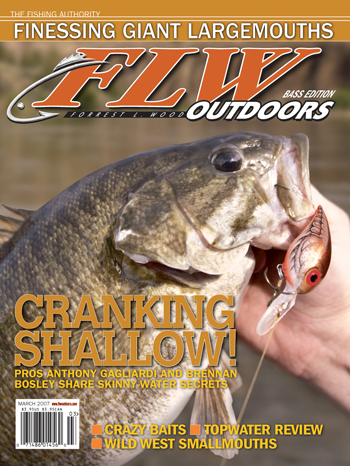
During early spring, when surface temperatures on lakes across the South begin creeping upward of 55 degrees, bass of all sizes are beckoned toward the shallows to carry out their paternal duties.
The gradual transition known as the prespawn is inherently routine for Micropterus salmoides (largemouth bass), but it can be a bewitching period for the crowds that chase them.
Bass are fat and sassy this time of year. Better yet, they are prone to congregate around cover and structure at water depths that make them vulnerable to a wide variety of lures and shallow-water fishing techniques.
Savvy anglers recognize the prespawn as a prelude to one of nature’s greatest shows. Stumble across the right spot, and you just might hook a gorilla – maybe more than one.
Reigning Wal-Mart FLW Tour Land O’Lakes Angler of the Year Anthony Gagliardi of Prosperity, S.C., and Wet Ones pro angler Brennan Bosley of Benton, Ark., are among the best in the business at finding and catching prespawn bass.
They are also among the best anglers on tour when fish are hanging tight to cover in water ranging from 2 to 8 feet. This is because both anglers have mastered the art of shallow cranking.
I call the tactic an art because that is exactly what it is. Anyone can toss a diving plug, bristling with treble hooks, into a maze of stumps, limbs, rocks or grass, but it takes serious skill to snake it through muck and consistently get it back.
Gagliardi has nailed down a pair of tour-level wins and bagged more than $650,000 in earnings since turning pro in 2000. Much of his earnings can be attributed to his crankbait prowess.
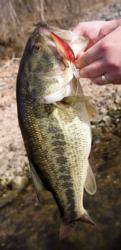 Bosley, meanwhile, joined the FLW Tour in 2003 and has since racked up more than $200,000 in winnings. The promising young pro said hard bodies have helped pad his bank account more than any other lures.
Bosley, meanwhile, joined the FLW Tour in 2003 and has since racked up more than $200,000 in winnings. The promising young pro said hard bodies have helped pad his bank account more than any other lures.
Interestingly, Gagliardi and Bosley finished No. 1 and No. 2, respectively, in the final standings at the 2006 FLW Tour Chevy Open held in February on Lake Murray in Columbus, S.C. Billed plugs played a huge factor in the big-bass slugfest, which divided $300,000 in cash between the top two spots alone.
In the segments that follow, the Ranger pros offer some valuable tips to help FLW Outdoors’ readers become more proficient – and confident – when the time is ripe to take those billed dogs hunting in skinny water.
Why crankbaits?
Gagliardi didn’t mince words when pitched the all-important question.
“The crankbait allows you to cover a great deal of water quickly and efficiently with a presentation that is really conducive to getting bites,” he said. “It simulates baitfish such as shad and perch, but it also does an excellent job of imitating crawfish, which are what bass tend to feed on heavily during early spring.”
Gagliardi added that shallow cranking is a great tactic to use during practice when you first arrive at a lake. However, he said it’s always wise to have a backup plan in case the fish get beat up or become finicky from being caught before the tournament begins.
“It is a great locator bait, one that allows you to put together a pattern pretty fast,” Gagliardi said. “But it may not be a pattern that will hold up over the course of an FLW Tour event, strictly because of the size of the field. Fish will still be there; you may just need to utilize a different technique to catch them when they count the most.”
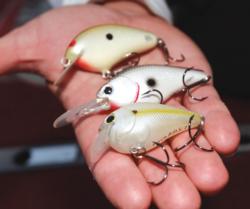 The downside to fishing crankbaits around shallow cover is obvious. The lures are adorned with treble hooks that will easily snag if you aren’t careful.
The downside to fishing crankbaits around shallow cover is obvious. The lures are adorned with treble hooks that will easily snag if you aren’t careful.
Still, a crankbait can be remarkably versatile when placed in the right hands. The trick to trouble-free cranking, said Gagliardi, is maintaining a high level of concentration to stay in touch with what the bait is doing at all times. When you feel trouble coming, slow down or stop the retrieve altogether. The lure will usually float free.
Easy does it
Gagliardi often sways from the standard crankbait drill when he is searching for bass around shallow cover and structure, especially wood and rock. Rather than chunking and winding, he likes to finesse his lure through limbs, over logs and around stumps and pilings.
“If you watched me from a distance and you didn’t know any better, you might think I was fishing a worm,” he said. “I’ll keep my rod tip high and actually use the rod to impart action on the bait. I’ll basically finesse the bait through cover. It takes some practice to become accustomed to it, but once you get it down, you can throw a crankbait into the same stuff you would throw a spinnerbait into.”

Gagliardi has a handful of lures he likes to use for cranking in skinny water. His favorite for fishing around wood, rock and dock support pilings is the Lucky Craft Fat CB BDS3. The plastic plug is designed to take a beating, is relatively buoyant and it deflects nicely off underwater targets.
Gagliardi puts some balsa into his game plan when paralleling floating docks. His go-to lure is Brian’s Bees Little Bee, a lightweight lure that maintains a fairly tight wobble.
Bosley turns and burns
Bosley knows from experience there will always be times when bass want a bait moving at a snail’s pace, but he always makes the bass tell him so before he downshifts to granny gear.
“The majority of the time, I am going to be rod tip down, turnin’ and burnin’ out there,” Bosley said. “To me, cranking in shallow water is strictly a reaction deal. I want the bait to be down there crashing around and bouncing off stuff because I think that’s what triggers the strike.”
Bosley’s super-aggressive approach worked beautifully at Lake Murray. The 32-year-old pro did the bulk of his damage in the vicinity of the dam, where he found isolated stretches of 8- to 9-foot water cluttered with large boulders the size of pickup trucks. Bass were suspended 3 to 4 feet deep around the rocks, and he used a Bomber Deep Flat A in dark brown crawdad pattern to exploit them.
“Probably 90 percent of the strikes I got during the Chevy Open came on the first cast, the second the bait deflected off the rocks,” Bosley said. “That’s usually the way it works, whether you are fishing around rocks, wood or grass. A bait might dart sideways, turn upside down or do something else out 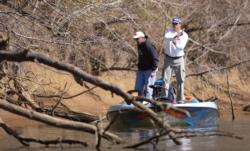 of the ordinary when it ricochets off a rock or a stump. I am convinced a bass has two choices when it sees that happen – either eat it or run the other way.”
of the ordinary when it ricochets off a rock or a stump. I am convinced a bass has two choices when it sees that happen – either eat it or run the other way.”
If there is a negative to Bosley’s aggressive approach to shallow cranking, it is hangups. He loses his share of hunting dogs, but he also manages to free quite a few with the help of a retractable dog leash and a Hound Dog Lure Retriever.
The Arkansas pro keeps the lure retriever attached to the leash at all times. The mechanical pulley winds in the retriever rope and keeps it out of the way.
Ambush points
Bass are object nuts – they like the security. Plus, they use objects as hiding spots to wage war on unsuspecting forage.
Then comes the all-important heat factor. Rocks, stumps, logs and submerged treetops absorb and displace heat. The water temperature around a large stump or rock may be slightly warmer than the surrounding area, which creates a natural magnet for cold-blooded critters.
Boat docks are also good spots to toss a crankbait. But as Gagliardi pointed out earlier, floating docks might demand a different approach than stationary structures built on pilings.
Color codes and action
Color scheme can be critical with crankbaits, but Gagliardi advised anglers to avoid falling into the color trap. The pro owns a truckload of hard bodies, but he typically makes use of only a handful of colors over the course of the year.
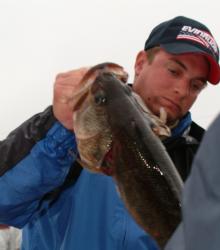 “Keep it basic,” Gagliardi said. “A crawfish pattern is always a necessity during spring. It is also a good idea to have something in shad pattern and something bright, maybe a chartrueuse with a black back for dirty-water applications.”
“Keep it basic,” Gagliardi said. “A crawfish pattern is always a necessity during spring. It is also a good idea to have something in shad pattern and something bright, maybe a chartrueuse with a black back for dirty-water applications.”
Crawfish-patterned lures have been awfully sweet to Bosley during the spring, but he isn’t hesitant to change if fish seem reluctant to take it.
Bosley said a reliable indicator of how well bass like a particular color is where the hooks wind up. If fish are consistently caught on the rear hook or on the outside of the mouth, it might be wise to swap colors until you find one fish will inhale.
“It is a process of elimination,” he said. “If one color pattern isn’t working, I’ll switch until I find the one they want. The same is true for lure action. Sometimes they want a bait with a tight wobble, whereas other times they want something with a wider wobble like a Storm Wiggle Wart.”
Be a shadow captain
Every bass angler has a pet peeve or two. Bosley has a thing about shadows. He hates to cast one on a potential target without running a crankbait past it first.
“I always try to fish into the sun so I don’t throw a shadow on a particular piece of cover before I am able to get a bait around it,” he said. “I don’t know if there is any truth to it or not, but I believe fish will spook from a shadow. I’ve seen it happen way too many times. It is a confidence thing.”
Inside and out
Many anglers write off a particular piece of cover without giving it a fair shake. If Bosley believes a spot is holding fish, he makes a point to give it plenty of opportunity to produce.
“If fish are aggressive, the strike will usually come the first time the bait crashes off that piece of cover,” he explained. “But if fish are sluggish after a front, I won’t hesitate to make 10 to 15 casts to one spot if I believe it is holding fish. I had one rock at Lake Murray that I would make 20 to 30 casts at, because it was good for at least one 6-pounder each day.”
Size matters
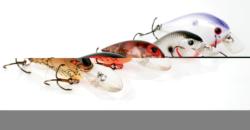 Bosley said he prefers throwing fairly small baits during early spring, but Gagliardi likes to throw larger ones if he can get away with it.
Bosley said he prefers throwing fairly small baits during early spring, but Gagliardi likes to throw larger ones if he can get away with it.
“That is especially true if the fish are feeding on bream,” Gagliardi said. “If I can throw a bigger bait and still get bites, I feel like that is going to increase my chances of catching the bigger fish over the course of the day. I’ll usually downsize if the weather changes, if the fish start acting finicky, or if I have some sort of visual evidence they are keying on smaller baitfish.”
The crankbait system
Fiberglass rods have always gotten a lot of play in crankbait arenas, largely due to their forgiving nature.
But not in Gagliardi’s court. He considers shallow cranking a power tactic, and his gear and line choices reflect the philosophy.
The rod he prefers for shallow cranking is a medium-heavy, 6-foot, 9-inch rod by Kistler. He matches it with 14- to 20-pound-test fluorocarbon. The only time he might deviate from the setup is if he is casting a lipless crankbait over grass or a billed plug over points with sparse cover.
“The main reason I like the stiffer rod is power,” Gagliardi said. “If I hook a 5-pounder around a laydown or brush pile, I want to be able to get the fish out of there.”
Gagliardi said the fluorocarbon line is well-suited for the application because it is very tough, yet sensitive enough to help him stay in tune with his bait at all times.
Bosley isn’t a big fan of fiberglass rods, either. In fact, his personal choice might surprise you.
“I’ve tried all kinds of rods that cost as much as $350, but the one I feel most comfortable with is a 7-foot Cranking Stick,” Bosley said. “It performs as well as anything I have used. It is not fiberglass, but it has the same parabolic bend you get with fiberglass and it’s a whole lot lighter.”
It’s fairly inexpensive, too. The last one Bosley bought cost him $29.95.
Interestingly, he has used the inexpensive rod to reel in more than $175,000 in earnings during the last two FLW Tour seasons.